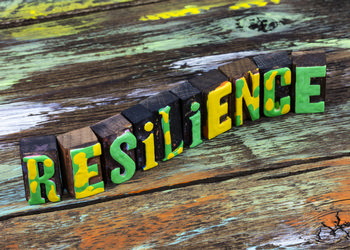The New 10 Traits of Emotionally Resilient People

Are We Suffering From a Resilience Hangover?
In recent years the topic of “psychological resilience” has experienced the life cycle of an A-list pop star sliding into infamous ruin. Yours truly wrote about it five years ago in a Psychology Today post, “10 Traits of Emotionally Resilient People.” Yet a couple years later, a book critic for The New York Times described resilience as “a word that is somehow so conveniently vacant that it manages to be profound and profoundly hollow.”
Is our collective “resilience” resilience waning?
My original article took a non-academic (i.e., applied/experiential) approach to the topic, because let’s be honest, most of us aren’t reading science journals. We want to know in layman’s terms how science can be applied to our daily lives, and we love a top-10 list. With my new 10 traits list below, I update my original article with some of the latest research to give resilience a refresh.
The New 10 Traits of Emotionally Resilient People
1. They self-regulate and set boundaries.
Resilient people understand that there is a separation between who they are at their core and the cause of their temporary suffering. A stressful or traumatic experience might play a part in their story, but it does not overtake their permanent identity. They regulate their emotional response to stress and practice acceptance of what they can and cannot change about the situation.
According to resilience researcher Sherry Hamby, “Self-regulation is the ability to maintain emotional, cognitive, and behavioral control, even during times of stress. It is the ability to experience and cope with feelings without becoming overwhelmed. It also involves the ability to make good choices even when tensions are high.”
Psychology writer Maria Konnikova writes that “the research of Martin Seligman, the University of Pennsylvania psychologist who pioneered much of the field of positive psychology . . . found that training people to change their explanatory styles from internal to external (“Bad events aren’t my fault”), from global to specific (“This is one narrow thing rather than a massive indication that something is wrong with my life”), and from permanent to impermanent (“I can change the situation, rather than assuming it’s fixed”) made them more psychologically successful and less prone to depression.”
2. They keep good company.
Resilient people tend to seek out and surround themselves with other resilient people when there’s a need for support. These supporters are our role models — a source of learning and inspiration for how they handle what life throws at them. Social support and sense of community consistently show up in research as one of the top resilience factors. As Dr. Romeo Vitelli tells us, “For people without this kind of support, loneliness can often contribute to the emotional aftermath of trauma and make recovery that much more difficult.”
3. They cultivate self-awareness.
Being “blissfully unaware” can get us through a bad day, but it’s not a very wise long-term strategy. Self-awareness helps us get in touch with our psychological and physiological needs — knowing what we need, what we don’t need, and when it’s time to reach out for some extra help. The self-aware are good at listening to the subtle cues their body and mood are sending. They understand when and where they are holding stress in their body, and when they might need a reframe of their current reactions to a stressor or trauma.
On the other end of the psychological spectrum, people might cling to an over-reliance on scientific explanations or a rigid sense of needing to stay strong at all times. A lack of psychological flexibility and vulnerability can make us emotional glaciers — always trying to be smart and strong in order to stay afloat, yet prone to massive stress fractures when we experience an unexpected change in our environment.
4. They practice acceptance.
Pain is painful, stress is stressful, and healing takes time. When we’re in it, we want the pain to go away. When we’re outside it, we want to take away the pain of those who we see suffering. Yet resilient people understand that stress and pain is a part of the ebb and flow of life. As hard as it is in the moment, it’s better to come to terms with the truth of the pain than to ignore it, repress it, or deny it. Acceptance is not about giving up and letting the stress take over; it’s about witnessing and experiencing the full range of emotions, trusting that we will bounce back, and absorbing lessons along the way.
5. They’re willing to sit in the space of non-judgment and not-knowing.
We are masters of judgment. There is a constant commentator in our head broadcasting an editorial about everything we encounter: That’s ugly. That’s stupid. That person was looking at me funny. So-and-so hates me. Life sucks. I’m not good enough. We are also masters of distraction. Smart phones, television, overeating, abusing drugs, risky behavior, gossip, etc., are all temporary distractions from the suffering created by external stressors and our internal commentator. There is now a large body of research indicating that mindfulness — part of which is being in the presence of the moment without succumbing to unhealthy distractions, and part of which is not assigning judgment to everything we encounter — enhances our psychological and physical well-being. It takes practice, but it requires nothing but willingness. One doesn’t need to sign up for classes, buy special gear, download apps, or travel to a specific place to meditate or take a more mindful approach to our daily lives.
6. They look for meaning.
Our resilience toolkit strengthens when we experience growth and learning opportunities as a result of stressful or traumatic events. According to Grych, Hamby, and Banyard’s Resilience Portfolio Model:
“Post-traumatic growth refers to deriving meaning from highly stressful experiences that lead to positive changes in views of self, the world, and/or relationships (Tedeschi & Calhoun, 2004). Whereas resilience is conceptualized as maintaining psychological health despite exposure to violence, post-traumatic growth is a healthy outcome that occurs because the individual experienced a stressful event.”
What does meaning look like? For some, meaning can be a newfound or strengthened sense of purpose or a prioritization of what matters most in their lives. Perhaps surviving violence or trauma gives them a reason to live, an affirmation of their life’s mission, or a sense of how they want to pass their legacy onto the next generation. For others, it can be a spiritual calling or the realization that they can transform their suffering into leadership or teaching opportunities.
7. They have a menu of self-care habits.
Resilient people have a list of positive habits that support them when they need it most. We can all become self-care spotters in our life — noticing those things that recharge our batteries and fill our cup. Dr. KarenHorneffer-Ginter, author of Full Cup, Thirsty Spirit, shares 25 soul-nourishing ideas, such as intentionally seeking out good news and the research-supported act of connecting with nature. But it’s not enough to know our self-care habits, we must intentionally make time for them. Perhaps that means starting a daily practice, such as exercising, meditating, or keeping a daily gratitude journal.
Speaking of journaling. When we’re in the midst of stress and overwhelm, our thoughts can swirl with dizzying speed and disconnectedness. We can find reprieve by getting the thoughts out of our head and onto paper. As Dr. James Pennebaker wrote in his book Writing to Heal, “People who engage in expressive writing report feeling happier and less negative than before writing. Similarly, reports of depressive symptoms, rumination and general anxiety tend to drop in the weeks and months after writing about emotional upheavals.”
Writing, journaling and talking about our emotions holds a mirror up to our current state of being. Seeing our words on paper or hearing them said aloud allows us to witness how we are coping with stress or trauma.
According to this Harvard Business Review article, resilience within our work lives is increased by taking breaks for mental recovery. “If you’re trying to build resilience at work, you need adequate internal and external recovery periods. As researchers Zijlstra, Cropley and Rydstedt write in their 2014 paper: “Internal recovery refers to the shorter periods of relaxation that take place within the frames of the workday or the work setting in the form of short scheduled or unscheduled breaks, by shifting attention or changing to other work tasks when the mental or physical resources required for the initial task are temporarily depleted or exhausted. External recovery refers to actions that take place outside of work — e.g. in the free time between the workdays, and during weekends, holidays or vacations. […] The very lack of a recovery period is dramatically holding back our collective ability to be resilient and successful. Research has found that there is a direct correlation between lack of recovery and increased incidence of health and safety problems.”
8. They practice an optimistic worldview.
Notice I didn’t say they inherently possess an optimistic worldview. Dr. Seligman points out in his book, Authentic Happiness, that we don’t have to be naturally optimistic to practice an optimistic worldview. For many of us, author included, that takes practice. We can catch our pessimism in the act and say, “No, that’s not who I am or who I want to be. What’s an alternative way of looking at this?”
So what is an optimistic worldview? Think of the most optimistic person in your life. I bet they aren’t always smiling or carrying around pom-poms like life’s little cheerleader, but they probably have a certain zest for life and are guided by a set of optimistic tenets and strong values. Perhaps they believe that people are inherently good, that things usually work out in the end, or that there’s a higher power looking out for them. Perhaps they refuse to accept that they are a victim of their circumstances and focus instead on what they have the power to change.
9. They entertain alternative endings.
We can’t rely on a crystal ball to predict our future, but we can train ourselves to ask which parts of our current story are permanent, and which can possibly change in the future. Can this situation be looked at in a different way that I haven’t been considering? Can I picture an alternative ending to this situation? This helps us maintain a realistic understanding that the present situation is being colored by our current interpretation. Our interpretations of our stories will always change as we grow and mature. Knowing that today’s interpretation can and will change gives us the faith and hope that things can be better tomorrow.
10. However, they also get out of their head.
In times of stress we try to make sense of our suffering. Why did this happen to me? Did I deserve this? Who did this to me? Why am I being punished? Why is life so unfair? Our answers to these questions create a narrative that we can either believe and cling to or witness and let float on by like clouds in the sky. By practicing the latter, we are far less likely to spin stories that are not grounded in reality — the little fictions that exacerbate our problems. Resilient people witness the spinning of yarns and step outside of themselves. They direct their mental and physical energies elsewhere, such as taking care of other people or engaging in their work or hobby.
An earlier version of this article was published on Psychology Today in 2013. It has been expanded and revised with the latest research on psychological resilience and post-traumatic growth. This article was originally published on PsychologyToday.com; used by permission from the author.
References:
https://www.psychologytoday.com/us/blog/media-spotlight/201804/what-makes-us-resilient?
https://www.newyorker.com/science/maria-konnikova/the-secret-formula-for-resilience
http://time.com/4306492/boost-emotional-resilience/
https://hbr.org/2016/06/resilience-is-about-how-you-recharge-not-how-you-endure
Brad Waters is a writer based in California with a background in social work and career consulting. In addition to creative writing, he writes about the intersection of personal development and career development, with a focus on creativity and the human-environment relationship. He holds a master's in social work from the University of Michigan and earned his B.A. in English from MSU in '01.
Contributing Writer(s): Brad Waters, '01



